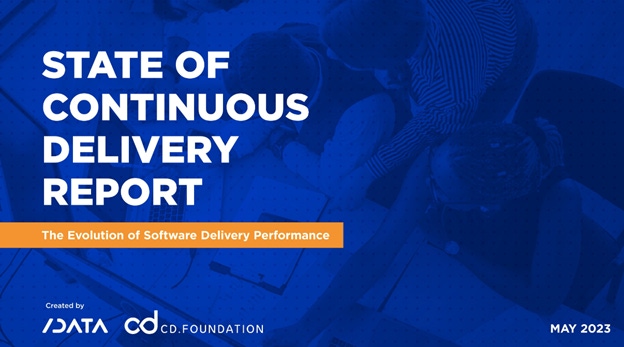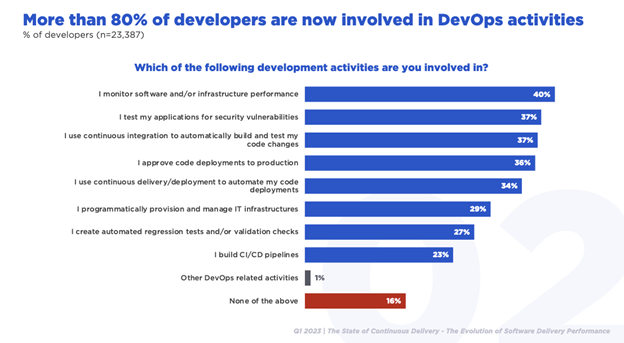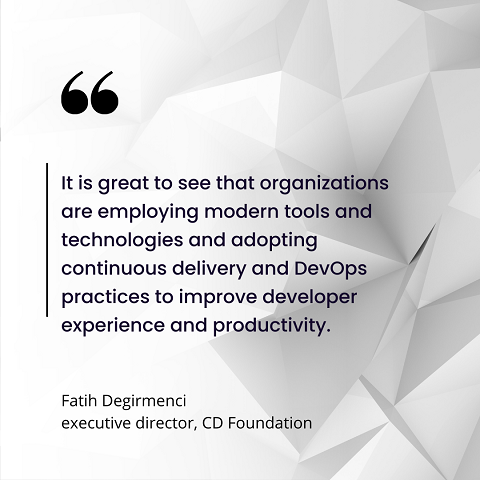CD Foundation State of Continuous Delivery Report Shows Growth in DevOpsCD Foundation State of Continuous Delivery Report Shows Growth in DevOps
The new report shows a high degree of DevOps participation by developers, though fully automating the process remains a challenge.

The Continuous Delivery Foundation (CDF) released its fourth State of Continuous Delivery Report this week, providing new insights into current trends in the DevOps landscape.
The report was released during the cdCon + GitOpsCon event that is part of the Linux Foundation's Open Source Summit, which runs May 8-12. The CDF hosts a number of critical open source DevOps projects, including Jenkins, Spinnaker, Tekton, and CDEvents. The new report is based on research conducted by SlashData, which benefits from the responses of 26,000 global respondents.
Among the top findings in the report:
DevOps practices adoption continues to increase, with 84% of developers actively participating.
Testing applications for security measures is the second most popular DevOps-related activity, with 37% of developers involved.
The utilization of continuous integration/continuous delivery (CI/CD) tools is associated with improved software delivery performance across all metrics.
The growing use of self-hosted CI/CD tools by DevOps practitioners does not necessarily lead to greater performance, possibly due to interoperability issues.

CDF-developers
"It is great to see that organizations are employing modern tools and technologies and adopting continuous delivery and DevOps practices to improve developer experience and productivity," Fatih Degirmenci, executive director of the CDF, told ITPro Today.
State of CD Report Reveals DevOps Challenges
While the report shows an overall growth in the adoption of DevOps practices, there are still numerous challenges.
"Even though the use of an increased number of DevOps tools helps organizations to perform better, the increased complexity continues to be a challenge that needs to be addressed," Degirmenci said.
While the growth in DevOps practices is a good trend, adoption is still very much a work in progress, Degirmenci said. He is hopeful that work to reduce the complexity of approaches such as developer platforms will alleviate some of the challenges.

Degirmenci-CDF
Platform engineering helps organizations abstract some of the low-level details away from the developers so they can focus on value-adding activities, according to Degirmenci. He noted, however, that while initial signs from organizations that have adopted platform engineering approaches are encouraging, the level of impact remains to be seen.
Automation and Interoperability Are Targets for Future DevOps Optimization
One area that Degirmenci is concerned about is the low percentage of organizations using continuous delivery to automate the various stages within their pipelines.
The report found that only 22% of developers are using continuous delivery to help automate the building, testing, and deployment of all code in a production environment.
"One of the reasons could possibly be the organizational and cultural changes required to fully benefit from continuous delivery, which could very well take time to achieve," he said.
Degirmenci also noted that the CD Foundation community and its projects have been putting a lot of effort in addressing one of the key challenges within the continuous delivery ecosystem — interoperability — with the CDEvents project leading the efforts.
"These efforts will ensure that the continuous delivery technologies could seamlessly be plugged into the platforms, since one of the objectives is to make the tools interoperate out of the box by natively supporting CDEvents, which has a great potential to be a foundational technology," he said.
About the Author
You May Also Like








.jpg?width=700&auto=webp&quality=80&disable=upscale)
